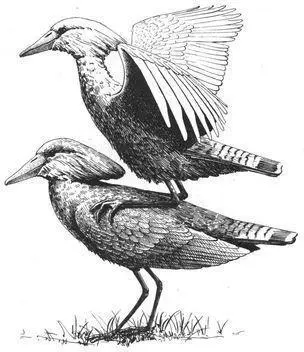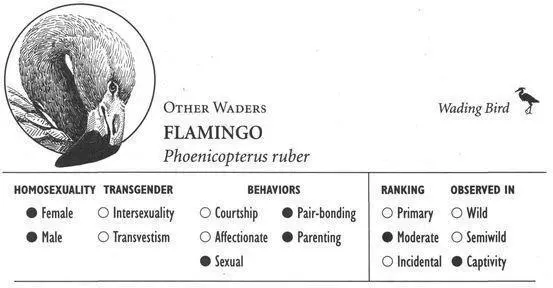Social Organization
Hammerheads are usually found in pairs or groups of 8–10 individuals, though larger groups of up to 50 birds may also congregate. The mating system is believed to involve monogamous pair-bonds. Couples build extraordinarily large domed nests, often several on the same territory.
Description
Behavioral Expression: Hammerheads engage in a striking group courtship ceremony that includes same-sex mounting. Gathering at dawn on open lawns, riverbanks, rocks, or in the trees, groups of 3—20 birds (including some mated pairs) begin calling in unison. Their calls consist of a series of loud, high-toned yips that develop into a rapid sequence of “purring” or trilling notes, often accompanied by wing-flapping. Two or more birds may then perform a NODDING DISPLAY to each other, in which the bill is rapidly bobbed up and down (sometimes still accompanied by the YIP-PURR chorus), or pairs of birds may run in circles side by side. The culmination of this spectacular display is a series of mountings, initiated when one bird runs up to another, drooping and flicking its wings while it raises and lowers its crest, or when one bird solicits another by crouching, cocking its tail, and partially opening its wings. One Hammerhead then hops onto the back of the other, similar to a heterosexual copulation—except that, in addition to males mounting females, males also mount other males, and females mount females as well as males. The mounting bird beats its wings and gives the YIP-PURR call, while the mounted bird presses its tail up against the lowered tail of the mounter (though no cloacal [genital] contact takes place). Sometimes the two birds face in opposite directions; reciprocal mounting (mounter and mountee exchanging positions, often several times in succession) also occurs, as do “pile-ups” of three or four birds all mounted on each other.
A female Hammerhead mounting another female

Frequency: Social courtship displays including ritualized same-sex mounting occur commonly in Hammerheads throughout the year. Each mounting session lasts for 10—40 minutes and may include dozens of mountings.
Orientation: All Hammerheads participate in group courtship displays, and most birds are probably involved in both same-sex and opposite-sex mountings.
Nonreproductive and Alternative Heterosexualities
As noted above, nonprocreative heterosexual activity (REVERSE mounting, as well as male-female mounts without cloacal contact) is common in Hammerheads. In addition, a significant percentage of heterosexual pairs may be nonbreeders. In some populations, as many as three-quarters of nests go unused (although some of these are “extra” nests built by breeding pairs), and couples may forgo breeding for four or more years at a time.
Other Species
Same-sex pairing occurs in semiwild White Storks (Ciconia ciconia) in some European populations, and individuals form homosexual pairs even when numerous opposite-sex partners are available. Same-sex pairs are able to successfully incubate, hatch, and raise foster young.
Sources
*asterisked references discuss homosexuality/transgender
*Brown, L. H. (1982) “Scopidae, Hamerkop.” In L. H. Brown, E. K. Urban, and K. Newman, eds., The Birds of Africa, vol. 1, pp. 168—72. London and New York: Academic Press.
*Campbell, K. (1983) “Hammerkops.” E.A.N.H.S. (East Africa Natural History Society) Bulletin (January-April): 11. 1.
Cheke, A. S. (1968) “Copulation in the Hammerkop Scopus umbretta.” Ibis 110:201—3.
*Elliott, A. (1992) “Scopidae (Hamerkop).” In J. del Hoyo, A. Elliott, and J. Sargatal, eds., Handbook of the Birds of the World, vol. 1, Ostrich to Ducks, pp. 430—35. Barcelona: Lynx Edicións.
Goodfellow, C. F. (1958) “Display in the Hamerkop, Scopus umbretta.” Ostrich 29:1—4.
Kahl, M. P. (1967) “Observations on the Behavior of the Hamerkop Scopus umbretta in Uganda.” Ibis 109:25—32.
*King, C. E. (1990) “Reproductive Management of the Oriental White Stork Ciconia boyciana in Captivity.” International Zoo Yearbook 29:85—90.
Stowell, R. F. (1954) “A Note on the Behavior of Scopus umbretta.” Ibis 96:150—51.
Wilson, R. T., and M. P. Wilson (1984) “Breeding Biology of the Hamerkop in Central Mali.” In J. Ledger, ed., Proceedings of the 5th Pan-African Ornithological Congress, pp. 855—65. Johannesburg: Southern African Ornithological Society.

IDENTIFICATION: The largest flamingo species (4–5 feet tall) with plumage ranging from pale whitish pink to bright orange-pink. DISTRIBUTION: The Mediterranean, sub-Saharan Africa, western Asia, Caribbean and Galapagos Islands, temperate South America. HABITAT: Shallow lakes, lagoons, mudflats, salt pans. STUDY AREAS: Zoo Atlanta, Georgia; Audubon Park Zoo, New Orleans, Louisiana; Chester Zoo, United Kingdom; Rotterdam Zoo, the Netherlands; Basel Zoo, Switzerland; subspecies P.r. roseus, the Greater Flamingo; P.r. ruber, the Caribbean Flamingo; and P.r. chilensis, the Chilean Flamingo.
Social Organization
Flamingos are extremely gregarious birds, often congregating in enormous groups numbering in the tens of thousands. During the mating season pair-bonds are formed and the birds nest in large colonies.
Description
Behavioral Expression: Flamingos form both male and female homosexual pairs. The bond is similar to that of a heterosexual mated pair and is expressed through shared activities, such as feeding and traveling together, calling in unison, helping each other in aggressive encounters against other birds, and sleeping side by side. The pair-bond is also reinforced through a number of stylized displays, such as ritual preening and feeding, as well as standing in an alert posture (with a graceful S-curve in the neck) in front of each other. Partners may even engage in mounting and copulations with one another; full genital contact occurs in matings between females, but not usually between males. Early in the breeding season, single male Flamingos also sometimes pursue other males in an attempt to mount them; this is known as DRIVING. Single males seeking male partners have even been known to harass heterosexual pairs, following them around and disrupting their copulations and incubation shifts in an attempt to gain access to the male.
Once formed, homosexual pair-bonds are strong and may persist from one breeding season to the next. Most pairings are monogamous; however, in some male pairs the partners also attempt to mount other birds (usually incubating birds of either sex). Sometimes two males and a female will even form a TRIAD in which the two males are bonded or sexually interested in each other as much, if not more so, than they are in the female. Homosexual partners sometimes also build nests together; in the case of male pairs, the nest (a pedestal-shaped mud platform) may become exceptionally large because of the contributions of both partners. Some male pairs, rather than building their own nest, “steal” or take over the nest of a heterosexual pair, occasionally breaking eggs in the process (this behavior also occurs between heterosexual pairs).
Читать дальше














